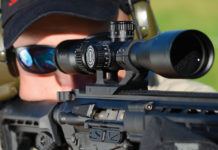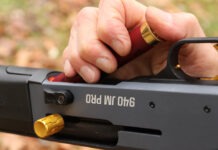Gun Digest contributor Phil Massaro explains the ins and outs of the ballistic coefficient and what it means when selecting the right bullet for the task at hand.
What is ballistic coefficient and why does it matter?
- Ballistic coefficient (BC) measures a bullet's ability to slice through the atmosphere.
- There are two standard models for calculating ballistic coefficient: G1 and G7.
- The ballistic coefficient figure is represented by a decimal less than 1.
- The higher the ballistic coefficient number, the better the bullet will fly.
- A high ballistic coefficient offers a flatter trajectory and less wind drift.
The term ballistic coefficient (BC) gets thrown around a lot in the shooting world, particularly with the long-range shooting crowd. And this talk is routine for those who are familiar with its meaning. But for the uninitiated, it might sound like the beginning of a complex algebraic equation.
Make no mistake, math is involved is formulating ballistic coefficient figures. But it's not a formula the average shooter needs to know, as most ammunition manufacturers offer those figures on their bullets freely.
Ballistic coefficient measures a bullet's ability to overcome air resistance in flight — basically, how well it cuts through the atmosphere. A high BC translates to a more aerodynamic bullet that is able to better resist the effects of wind and gravity. This is important information with regard to bullet selection and a shooter's intended purpose, especially as range increases.
If you're hunting deer in thick timber in the Midwest or the East and shots are generally within 200 yards, your chosen projectile's ballistic coefficient doesn't matter as much. At those distances, your bullet is traveling fast enough and for a short enough time before impact that wind and gravity won't have as huge of an impact on your bullet's trajectory.
If you're hunting in the plains or out West, where the open terrain often mandates longer shots, then ballistic coefficient is a much larger factor and one that should be taken into consideration when selecting your bullet. If you're a dedicated long-range shooter, BC is never far from your mind. In both of these applications, because of the distance, wind and gravity have a longer time to affect your bullet's trajectory, which is why a projectile with a high ballistic coefficient that slices efficiently through the air is so beneficial.
To learn the basics of ballistic coefficient, check out the video above, which features Gun Digest contributor Phil Massaro. Massaro is an expert on reloading and ballistics and has written extensively on those subjects.

Next Step: Get your FREE Printable Target Pack
Enhance your shooting precision with our 62 MOA Targets, perfect for rifles and handguns. Crafted in collaboration with Storm Tactical for accuracy and versatility.
Subscribe to the Gun Digest email newsletter and get your downloadable target pack sent straight to your inbox. Stay updated with the latest firearms info in the industry.




![Best Concealed Carry Guns In 2025 [Field Tested] Wilson Combat EDC X9S 1](https://gundigest.com/wp-content/uploads/Wilson-Combat-EDC-X9S-1-324x160.jpg)


![Best 9mm Carbine: Affordable PCCs [Tested] Ruger Carbine Shooting](https://gundigest.com/wp-content/uploads/Ruger-Carbine-Shooting-100x70.jpg)
![Best AR-15: Top Options Available Today [Field Tested] Harrington and Richardson PSA XM177E2 feature](https://gundigest.com/wp-content/uploads/Harrington-and-Richardson-PSA-XM177E2-feature-100x70.jpg)
